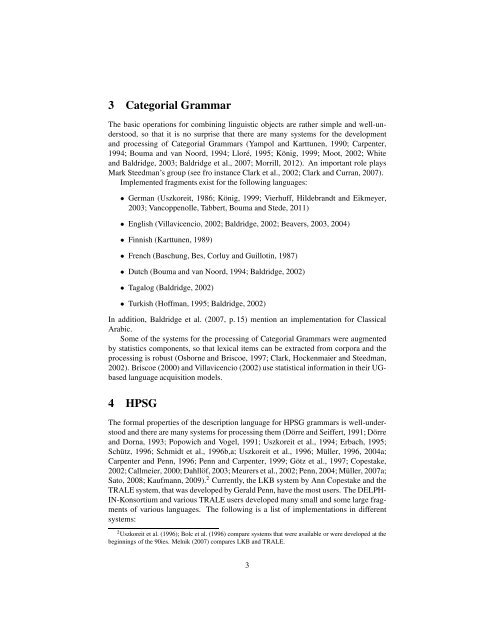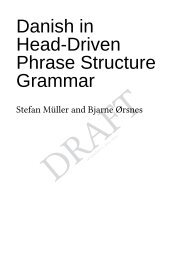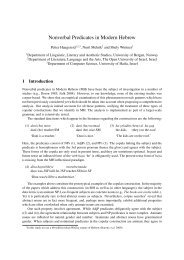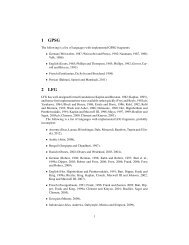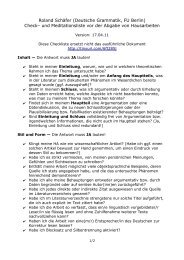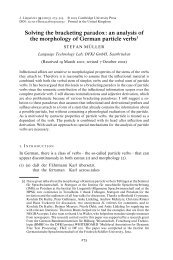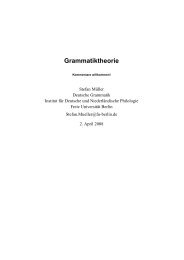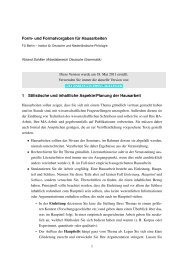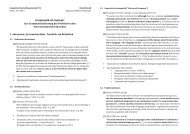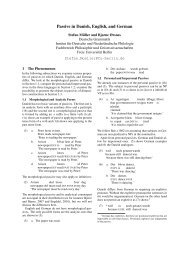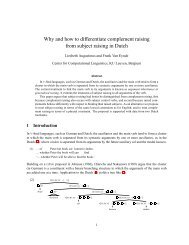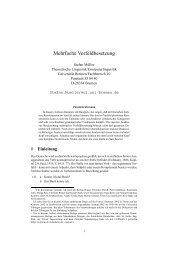1 GPSG 2 LFG - German Grammar Group FU Berlin - Freie ...
1 GPSG 2 LFG - German Grammar Group FU Berlin - Freie ...
1 GPSG 2 LFG - German Grammar Group FU Berlin - Freie ...
You also want an ePaper? Increase the reach of your titles
YUMPU automatically turns print PDFs into web optimized ePapers that Google loves.
3 Categorial <strong>Grammar</strong><br />
The basic operations for combining linguistic objects are rather simple and well-understood,<br />
so that it is no surprise that there are many systems for the development<br />
and processing of Categorial <strong>Grammar</strong>s (Yampol and Karttunen, 1990; Carpenter,<br />
1994; Bouma and van Noord, 1994; Lloré, 1995; König, 1999; Moot, 2002; White<br />
and Baldridge, 2003; Baldridge et al., 2007; Morrill, 2012). An important role plays<br />
Mark Steedman’s group (see fro instance Clark et al., 2002; Clark and Curran, 2007).<br />
Implemented fragments exist for the following languages:<br />
• <strong>German</strong> (Uszkoreit, 1986; König, 1999; Vierhuff, Hildebrandt and Eikmeyer,<br />
2003; Vancoppenolle, Tabbert, Bouma and Stede, 2011)<br />
• English (Villavicencio, 2002; Baldridge, 2002; Beavers, 2003, 2004)<br />
• Finnish (Karttunen, 1989)<br />
• French (Baschung, Bes, Corluy and Guillotin, 1987)<br />
• Dutch (Bouma and van Noord, 1994; Baldridge, 2002)<br />
• Tagalog (Baldridge, 2002)<br />
• Turkish (Hoffman, 1995; Baldridge, 2002)<br />
In addition, Baldridge et al. (2007, p. 15) mention an implementation for Classical<br />
Arabic.<br />
Some of the systems for the processing of Categorial <strong>Grammar</strong>s were augmented<br />
by statistics components, so that lexical items can be extracted from corpora and the<br />
processing is robust (Osborne and Briscoe, 1997; Clark, Hockenmaier and Steedman,<br />
2002). Briscoe (2000) and Villavicencio (2002) use statistical information in their UGbased<br />
language acquisition models.<br />
4 HPSG<br />
The formal properties of the description language for HPSG grammars is well-understood<br />
and there are many systems for processing them (Dörre and Seiffert, 1991; Dörre<br />
and Dorna, 1993; Popowich and Vogel, 1991; Uszkoreit et al., 1994; Erbach, 1995;<br />
Schütz, 1996; Schmidt et al., 1996b,a; Uszkoreit et al., 1996; Müller, 1996, 2004a;<br />
Carpenter and Penn, 1996; Penn and Carpenter, 1999; Götz et al., 1997; Copestake,<br />
2002; Callmeier, 2000; Dahllöf, 2003; Meurers et al., 2002; Penn, 2004; Müller, 2007a;<br />
Sato, 2008; Kaufmann, 2009). 2 Currently, the LKB system by Ann Copestake and the<br />
TRALE system, that was developed by Gerald Penn, have the most users. The DELPH-<br />
IN-Konsortium and various TRALE users developed many small and some large fragments<br />
of various languages. The following is a list of implementations in different<br />
systems:<br />
2 Uszkoreit et al. (1996); Bolc et al. (1996) compare systems that were available or were developed at the<br />
beginnings of the 90ies. Melnik (2007) compares LKB and TRALE.<br />
3


